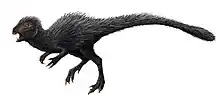| Taveirosaurus Temporal range: Late Cretaceous, | |
|---|---|
| Scientific classification | |
| Domain: | Eukaryota |
| Kingdom: | Animalia |
| Phylum: | Chordata |
| Clade: | Dinosauria |
| Clade: | †Ornithischia |
| Genus: | †Taveirosaurus Antunes & Sigogneau-Russell, 1991 |
| Species: | †T. costai |
| Binomial name | |
| †Taveirosaurus costai Antunes & Sigogneau-Russell, 1991 | |
Taveirosaurus (meaning "Taveiro lizard") is a genus of ornithischian dinosaur from the Late Cretaceous Argilas de Aveiro Formation of Portugal, and also Laño, Spain. The genus is based solely on teeth, and the type species is T. costai.[1]
Discovery and naming
In 1968, Miguel Telles Antunes and Giuseppe Manuppella uncovered fossils at the Cerâmica do Mondego quarry near Taveiro, a village in Portugal, southwest of Coimbra. Among them were a number of low triangular teeth of a herbivorous dinosaur. In 1991 these were named and described by Telles Antunes and Denise Sigogneau-Russell as the type species, Taveirosaurus costai. The generic name refers to Taveiro. The specific name honours the Portuguese geologist João Carrington da Costa.[1]
The holotype, CEGUNL-TV 10, was found in ancient river clay of the Argilas de Aveiro Formation dating from the Maastrichtian. It consists of one tooth. Nine other teeth were also assigned to the genus, CEGUNL-TV 6–9, 11 and 13–16. Later, more teeth found near Laño in Spain were referred to Taveirosaurus.[2]
Classification
Having only the teeth to base themselves on, Telles Antunes and Sigogneau originally thought that Taveirosaurus belonged to some pachycephalosaurian group. In 1991 they assigned it to the Homalocephalidae, in 1992 to the Pachycephalosauridae.[3] However, they soon rejected this possibility, and Taveirosaurus has not been included in this group in recent reviews.[2][4][5] In 1995, it was considered to be a member of the Nodosauridae.[6] In 1996 Peter Galton suggested it might have belonged to the Fabrosauridae, pointing out a similarity to the teeth of Alocodon and Trimucrodon, two other "tooth genera".[7] In 2004 David B. Norman concluded it was a nomen dubium and was unable to identify Taveirosaurus further than Ornithischia.[2]
References
- 1 2 M. Telles Antunes & D. Sigogneau-Russell, (1991), "Nouvelles données sur les dinosaures du Crétacé supérieur du Portugal, Comptes Rendus de l'Académie des Sciences à Paris, Série II 313: 113-119
- 1 2 3 Norman, David B.; Witmer, Larry M.; Weishampel, David B. (2004). "Basal Ornithischia". In Weishampel, David B.; Dodson, Peter; Osmólska, Halszka (eds.). The Dinosauria (2nd ed.). Berkeley: University of California Press. pp. 325–334. ISBN 978-0-520-24209-8.
- ↑ M. Telles Antunes & D. Sigogneau, (1992), "La faune des petits dinosaures du Crétacé terminal portugais", Comunicações dos Serviços Geológicos de Portugal 78(1): 49-62
- ↑ Maryańska, Teresa; Chapman, Ralph E.; Weishampel, David B. (2004). "Pachycephalosauria". In Weishampel, David B.; Dodson, Peter; Osmólska, Halszka (eds.). The Dinosauria (2nd ed.). Berkeley: University of California Press. pp. 464–477. ISBN 978-0-520-24209-8.
- ↑ Sullivan, Robert M. (2006). "A taxonomic review of the Pachycephalosauridae (Dinosauria:Ornithischia)" (PDF). Late Cretaceous Vertebrates from the Western Interior. New Mexico Museum of Natural History and Science Bulletin. 35: 347–366. Retrieved 2010-11-10.
- ↑ M. Telles Antunes & D. Sigogneau-Russell, (1995), "O Cretácico terminal português e o seu contributo para o esclarecimento da extinção dos dinossauros", Mem. Acad. Ciênc. Lisb. 35(1995): 131–144
- ↑ P.M. Galton. (1996). "Notes on Dinosauria from the Upper Cretaceous of Portugal". Neues Jahrbuch für Geologie und Paläontologie Monatshefte 1996(2): 83-90

